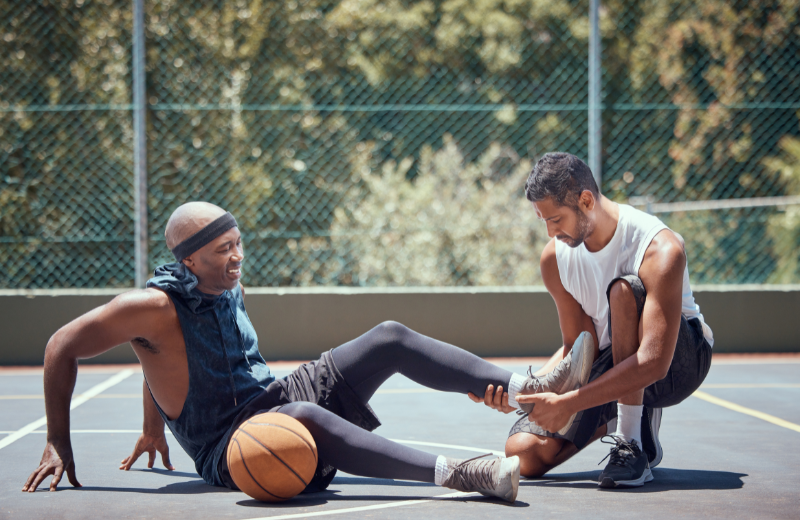
With March Madness approaching, weekend warriors and parents of players may be curious about the most common basketball injuries. Understanding them can lower your risk and speed up your recovery.
“Basketball is all about fast cuts and jumping, and the most common acute injuries follow from those forceful movements,” said UAB Sports & Exercise Medicine orthopaedic surgeon Amit Momaya, M.D. “Risk for these and other injuries can also result from a lack of physical preparedness and recovery.”
The four most common basketball injuries are highlighted below:
- Ankle sprain: Perhaps the most common basketball injuries, ankle sprains often happen after jumps – either from landing on the side of the foot or sliding off another player’s foot on the way down. Sprains can take weeks to recover from, but physical therapy can speed that up.
- How to tell if it’s a sprain: Assess whether the foot can move and then whether it can bear weight. If the answer to both is yes, it’s likely a sprain rather than a break.
- What to do next: In the short term, Dr. Momaya recommends ice, compression, and elevation, with nonsteroidal anti-inflammatory drugs (NSAIDs) such as ibuprofen for pain relief. If the ankle swells severely or movement and weight-bearing become more limited, it is important to visit a sports medicine physician to make sure it’s not a break.
- ACL tear: The anterior cruciate ligament (ACL) runs through the front center of the knee and joins the thigh bone to the shin bone. It is vulnerable to twisting forces, such as when landing from a rotating jump or pivoting the foot.
- How to tell if it’s an ACL tear: If you hear a loud pop, see a visible shift in the knee, cannot bear weight, and encounter swelling, there’s a good chance it is a tear. Partial ACL tears are also possible. “You should never try to play on a suspected ACL injury or try to walk it off,” Dr. Momaya said. “You can cause other kinds of damage that complicate treatment and recovery.”
- What to do next: A sports medicine physician should examine your knee, using X-ray and magnetic resonance imaging (MRI) scans to confirm a tear and determine how bad it is. A speedy diagnosis, reconstruction surgery, and closely monitored physical therapy are the keys to a faster and more effective recovery.
“An ACL tear is a common injury that we can treat successfully, but patients need to keep a positive outlook and commit to the nine-month-plus program of recovery,” Dr. Momaya said.
- Meniscus tear: The meniscus is a shock-absorbing type of strong, flexible connective tissue known as cartilage that’s located in the knee joint. It can tear with weight-bearing and twisting motions, and the injury can range from mild to severe.
- How to tell if it’s a meniscus tear: Meniscus tears can have similar symptoms as ACL tears, because they result from the same forces, and they often occur at the same time. However, meniscus tears tend to be less severe and immobilizing than ACL tears. Symptoms may be immediate or delayed and can include knee pain, an inability to bear weight, and feeling “stuck”.
- What to do next: A sports medicine physician should judge the seriousness of the injury. With proper rehabilitation therapy, some minor meniscus tears can heal without surgery. Surgery to repair more serious tears can take several months to recover from. “It’s important to not ‘wait and see’ when it comes to knee injuries, because that can jeopardize your recovery and future mobility,” Dr. Momaya said.
- Achilles tendon tear: The Achilles tendon connects the calf muscle to the ankle and allows you to jump and stand on your toes.
- How to tell if it’s an Achilles tendon tear: If you have a sharp pain near your calf and cannot jump, Dr. Momaya suggests trying two self-tests to help determine if your Achilles tendon is torn. First, feel the taut, ropey tendons just above both heels. If the injured side feels looser than the other, there’s a good chance that you’ve torn it. Second, try squeezing your calf muscle with your hands while your leg is relaxed. If your foot tilts downward when you squeeze, the tendon is working.
- What to do next: “Achilles tendon scarring can happen within a few weeks, which could limit your range of motion and athletic performance,” said Dr. Momaya, adding that he recommends seeing a sports medicine physician immediately for this type of injury. “We have some advanced techniques that can get you into rehab and recovery mode quicker, such as the ‘bridge and anchor’ repair used on Aaron Rodgers in 2023. Identifying the injury quickly is key.”
The importance of proper care
“Repeated stress without adequate recovery increases your injury risk across the board,” Dr. Momaya said. “It is important to work within the bounds of your ability and control how many full-speed sport days, technique days, and training days you plan.”
If you do get injured, receiving care from a sports medicine team provides important benefits for both dedicated athletes and weekend warriors, including:
- Less time between injury and diagnosis
- Treatment that’s based on the latest sports medicine research
- A coordinated care plan and treatment with specific timelines
- Access to all specialists relevant to sports medicine, including surgeons, imaging experts, nutritionists, physical therapists, and psychologists
- Care that’s based on experience in treating athletes of all ages and performance levels, including professional players
Click here to learn more about UAB Sports & Exercise Medicine or to make an appointment.
